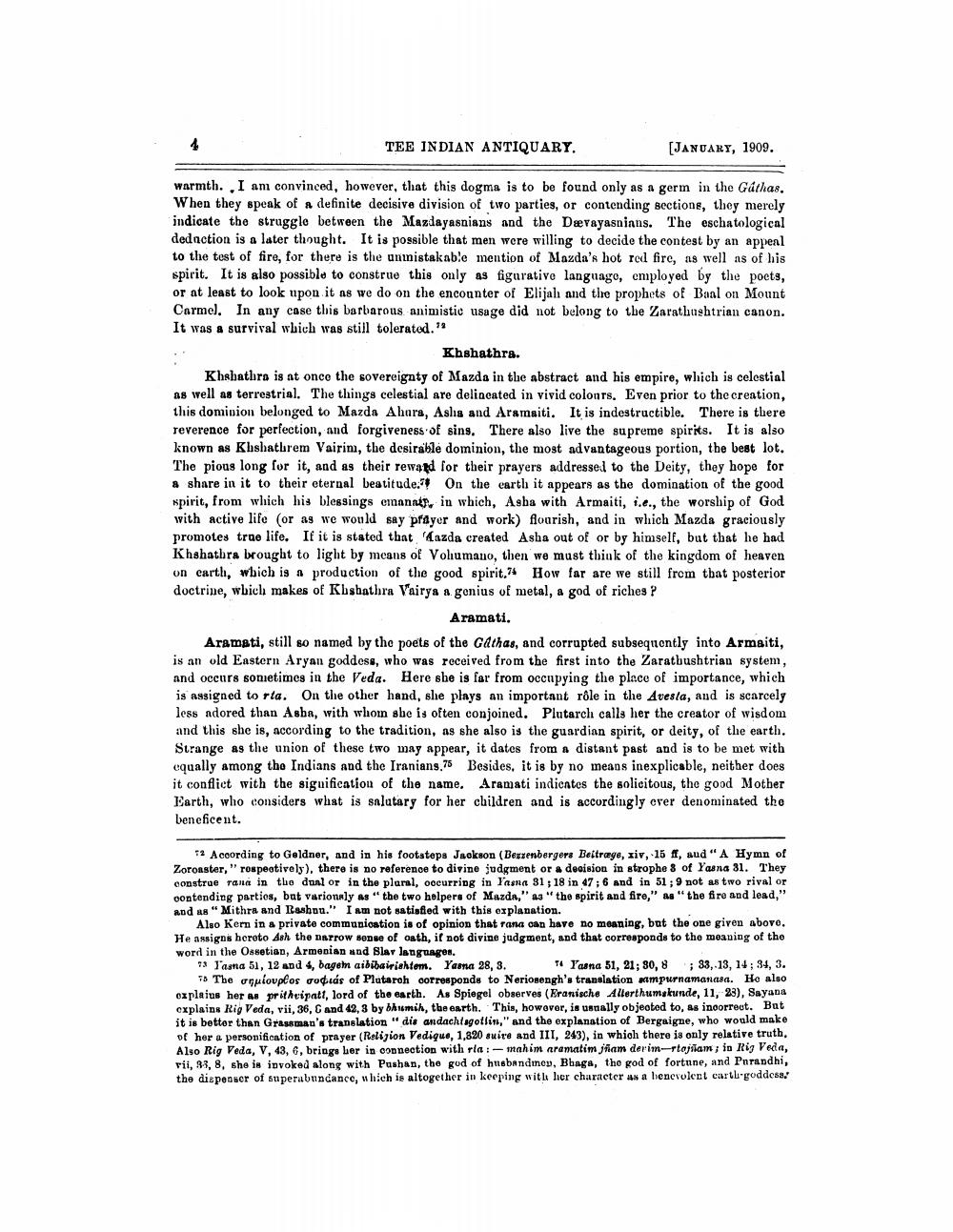________________
TEE INDIAN ANTIQUARY.
(JANUARY, 1909.
warmth. I am convinced, however, that this dogma is to be found only as a germ in the Gáthas. When they speak of a definite decisive division of two parties, or contending sections, they merely indicate the struggle between the Mazdayasnians and the Dævayasninns. The eschatological dedaction is a later thought. It is possible that men were willing to decide the contest by an appeal to the test of fire, for there is the unmistakable mention of Mazda's hot rod fire, as well as of his spirit. It is also possible to construe this only as figurative language, employed by the poets, or at least to look upon it as we do on the encounter of Elijah and the prophets of Baal on Mount Carmel. In any case this barbarous animistic usage did not belong to the Zarathushtrian canon. It was a survival which was still tolerated."
Khshathra. Khshathra is at once the sovereignty of Mazda in the abstract and his empire, which is celestial as well as terrestrial. The things celestial are deliacated in vivid colours. Even prior to the creation, this dominion belonged to Mazda Ahura, Aslis and Aramaiti. It is indestructible. There is there reverence for perfection, and forgiveness of sins. There also live the supreme spirits. It is also known as Khshathrem Vairim, the desirable dominion, the most advantageous portion, the best lot. The pious long for it, and as their reward for their prayers addressed to the Deity, they hope for & share in it to their eternal beatitude. On the earth it appears as the domination of the good spirit, from which his blessings crannus, in which, Asba with Armaiti, i.e., the worship of God with active life (or as we would say prayer and work) fogrish, and in which Mazda graciously promotes trae life. If it is stated that Mazda created Asha out of or by himself, but that he had Khshathra brought to light by means of Vohumano, then we must think of the kingdom of heaven on carth, which is a production of the good spirit.74 How far are we still from that posterior doctrine, wbich makes of Kbshathra Vairya a genius of metal, a god of riches ?
Aramati. Aramati, still so named by the poets of the Gathas, and corrupted subsequently into Armaiti, is an old Eastern Aryan goddess, who was received from the first into the Zaratbushtrian system, and occurs sonetimes in the Veda. Here she is far from occupying the place of importance, which is assigned to rta. On the other hand, she plays an important role in the Avesla, and is scarcely less adored than Asha, with whom she is often conjoined. Plutarch calls her the creator of wisdom and this she is, according to the tradition, as she also is the guardian spirit, or deity, of the earth. Strange as the union of these two may appear, it dates from a distant past and is to be met with equally among the Indians and the Iranians.75 Besides, it is by no means inexplicable, neither does it conflict with the siguification of the name. Aramati indicates the solicitous, the good Mother Earth, who considers what is salutary for her children and is accordingly crer denominated the beneficent.
12 A coording to Geldner, and in his footsteps Jackson (Bezzenbergers Beitræge, xiv, 15 ff, aud "A Hymn of Zoroaster, "rospectively), there is no reference to divine judgment or a decision in strophe 3 of Yasna 31. They construe rana in the dual or in the plural, oocurring in Yasna 31:18 in 47:6 and in 51 ; 9 not as two rival or contending parties, but varionnly as "the two holpers of Mazda," as "the spirit and fire," as "the fire and lead," and as "Mithra and Rashou." I am not satisfied with this explanation.
Also Kern in a private communication is of opinion that rana can have no meaning, but the one given above. He assignis hereto Ash the narrow sense of oath, if not divine judgment, and that corresponds to the meaning of the word in the Ossetian, Armenian and Slar languages. 13 Yasna 51, 12 and 4, bagem aibibairishtom. Yasna 28, 3.
Pasna 31, 21; 80,8 ; 33, 13, 14; 34, 3. 76 The oqulovplos podrás of Plutarch corresponds to Neriosengh's translation simpurnamantasa. He also oxplaius her as prithvipatt, lord of the earth. As Spiegel observes (Eranische Allerthumskunde, 11, 23), Sayada explains Rig Veda, vii, 36, C and 42,3 by bhumih, the earth. This, howover, is usually objeoted to, as incorrect. But it is better than Grassman's translation " dia andachtsgotin," and the explanation of Bergaigne, who would make of her a personification of prayer (Religion Vedique, 1,820 suite and III, 243), in which there is only relative truth. Also Rig Veda, V, 43, 6, brings her in connection with ria:- mahim aramatim jfiam derim-tajiiam ; in Rig Veda, rii, 93, 8, she is invoked along with Pushan, the gud of husbandıncy, Bhaga, the god of fortune, and Purandhi, the dispenser of superabundance, which is altogether in keeping with lier character 45 a lienevolent cartli goddess."




